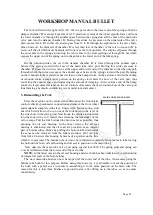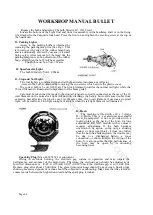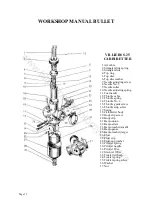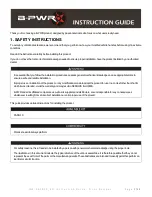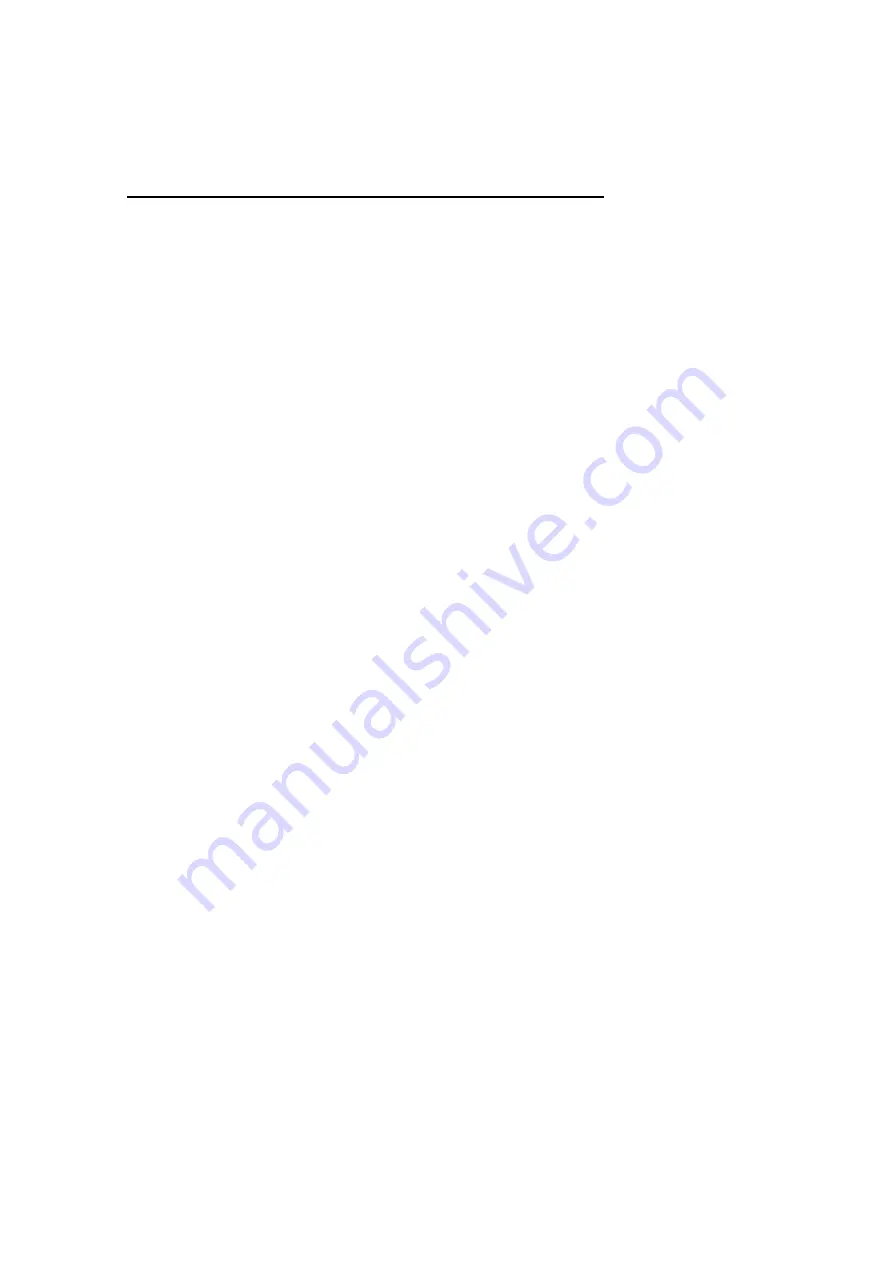
WORKSHOP MANUAL BULLET
Page 57
TYRES - REMOVAL AND REPLACEMENT
1. At some time or other the need will arise to remove and replace the tyres, either as a result of a
puncture or because renewal is required to offset wear. To the inexperienced, tyre changing represents a
formidable task, yet if a few simple rules are observed and the technique learned the whole operation is
surprisingly simple.
2. To remove the tyre from either wheel, first detach the wheel from the machine. Deflate the tyre by
removing the valve insert and when it is fully deflated push the beading of the tyre away from the wheel
rim on both sides so that the beading enters the centre well of the rim. Remove the locking cap and push
the tyre valve into the tyre.
3. Insert two tyre levers close to the valve, on either side of the valves and lever the edge of the tyre over
the outside of the wheel rim. Very little force should be necessary; if resistance is encountered it is
probably due to the fact that the tyre beading have not come off the wheel rim all around the tyre.
4. Once the tyre has been edged over the wheel rim, it is easy to work around the wheel rim so that the
tyre is completely free on one side. At this stage, the inner tube can be removed.
5. Working from the other side of the wheel, ease the other edge of the tyre over the wheel rim. Continue
to work around the rim until tyre is free completely from the rim.
6. If a puncture has necessitated the removal of the tyre, reinflate the inner tube and immerse it in water
to trace the source of the leak. Mark its position and deflate the tube. Dry the tube and clean the area
around the puncture with a petrol soaked rag. When the surface has dried, apply rubber solution and
allow this to dry before removing the protective sticker from a patch and applying the patch to the
surface.
7. It is best to use a patch of the self-vulcanising type, which will form a very permanent repair. Note that
it may be necessary to remove another protective covering from the top surface of the patch, after it has
sealed in position. Inner tubes made from synthetic rubber may require a special type of patch and
adhesive if a satisfactory bond is to be achieved.
8. Before replacing the tyre, check the inside of it to remove the foreign particle which caused the
puncture. Check the outside of the tyre, particularly the tread area, to make sure nothing is trapped that
may cause a further puncture.
9. If the inner tube has been patched on a number of past occasions, or if there is tear or large hole, it is
preferable to discard it and fit a new tube.
10. To replace the tyre, inflate the inner tube just sufficiently for it to assume a circular shape. Then push
it into the tyre so that it is enclosed completely. Lay the tyre on the wheel at an angle and insert the valve
through the rim tape and the hole in the wheel rim. Attach the locking cap on the first few threads,
sufficient to hold the valve captive in its correct location.
11. Starting at the point furthest away from the valve, push the tyre beading over the edge of the wheel
rim until it is located in the central well. Continue to work around the tyre in the fashion until the whole
of one side of the tyre is on the rim. It may be necessary to use a tyre lever during the final stages.
www.hitchcocksmotorcycles.com
Summary of Contents for 350 BULLET 1989
Page 9: ...WORKSHOP MANUAL BULLET Page 9 w w w h i t c h c o c k s m o t o r c y c l e s c o m ...
Page 17: ...w w w h i t c h c o c k s m o t o r c y c l e s c o m ...
Page 34: ...WORKSHOP MANUAL BULLET Page 34 w w w h i t c h c o c k s m o t o r c y c l e s c o m ...
Page 37: ...w w w h i t c h c o c k s m o t o r c y c l e s c o m ...
Page 41: ...WORKSHOP MANUAL BULLET Page 41 w w w h i t c h c o c k s m o t o r c y c l e s c o m ...
Page 58: ...WORKSHOP MANUAL BULLET Page 58 w w w h i t c h c o c k s m o t o r c y c l e s c o m ...
Page 69: ...WORKSHOP MANUAL BULLET Page 69 w w w h i t c h c o c k s m o t o r c y c l e s c o m ...
Page 73: ...w w w h i t c h c o c k s m o t o r c y c l e s c o m ...
Page 77: ...w w w h i t c h c o c k s m o t o r c y c l e s c o m ...
Page 103: ...w w w h i t c h c o c k s m o t o r c y c l e s c o m ...
Page 105: ...w w w h i t c h c o c k s m o t o r c y c l e s c o m ...
Page 107: ...WORKSHOP MANUAL BULLET Page 107 w w w h i t c h c o c k s m o t o r c y c l e s c o m ...
Page 108: ...WORKSHOP MANUAL BULLET Page 108 w w w h i t c h c o c k s m o t o r c y c l e s c o m ...
Page 109: ...WORKSHOP MANUAL BULLET Page 109 w w w h i t c h c o c k s m o t o r c y c l e s c o m ...
Page 110: ...WORKSHOP MANUAL BULLET Page 110 w w w h i t c h c o c k s m o t o r c y c l e s c o m ...
Page 111: ...WORKSHOP MANUAL BULLET Page 111 w w w h i t c h c o c k s m o t o r c y c l e s c o m ...
Page 113: ...WORKSHOP MANUAL BULLET Page 113 w w w h i t c h c o c k s m o t o r c y c l e s c o m ...



